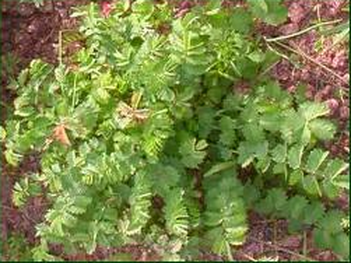
Salad Burnet - In February many long for a toasted cucumber and tomato sandwich or sliced cucumbers with a meal. For some it is a longing they can't give in to because cucumbers bother their digestion. Salad burnet is a little known herb whose leaves have a distinctive cucumber taste and won't cause indigestion! If plants are brought inside in the fall we could have that great cucumber taste all winter. I have been introducing this herb in herb growing courses and everyone has been intrigued by it. A short-lived perennial to zone 4, salad burnet has had medicinal uses for 2000 years but is mainly grown for culinary purposes now.
The plant grows to a height of one foot with deep-green serrated leaves, often with reddish stems. The flower is purplish-red in a nut-like formation and can be used the same as the leaves. Seeds can be started indoors 4-6 weeks before the last frost .
Cover the pot with paper to keep the darkness. Sow thickly to have a good clump to transplant outside after the frost deadline. Mature plants have a long taproot and resent transplanting so move plants while they are small. They self-seed readily. Watch for little clusters of bright green leaves close to the mature plants in the early spring and transplant them when they are a few inches high. Set plants 12-18 inches apart.
Like most herbs, salad burnet likes the sun and well drained soil. Pick the young leaves before the flowers open to snip into a salad for a nutty cucumber flavour. Lay a few leaves on tomatoes in a sandwich. Salad burnet leaves will flavour cream cheese, soup, sour cream dips, vinegars - anywhere you want a cucumber flavour. Let some plants go to flower and use in the same way. The blooming plants also make a nice display in the herb garden. The leaves of salad burnet lose some flavour when dried so enjoy them while they are fresh.
The plant grows to a height of one foot with deep-green serrated leaves, often with reddish stems. The flower is purplish-red in a nut-like formation and can be used the same as the leaves. Seeds can be started indoors 4-6 weeks before the last frost .
Cover the pot with paper to keep the darkness. Sow thickly to have a good clump to transplant outside after the frost deadline. Mature plants have a long taproot and resent transplanting so move plants while they are small. They self-seed readily. Watch for little clusters of bright green leaves close to the mature plants in the early spring and transplant them when they are a few inches high. Set plants 12-18 inches apart.
Like most herbs, salad burnet likes the sun and well drained soil. Pick the young leaves before the flowers open to snip into a salad for a nutty cucumber flavour. Lay a few leaves on tomatoes in a sandwich. Salad burnet leaves will flavour cream cheese, soup, sour cream dips, vinegars - anywhere you want a cucumber flavour. Let some plants go to flower and use in the same way. The blooming plants also make a nice display in the herb garden. The leaves of salad burnet lose some flavour when dried so enjoy them while they are fresh.
